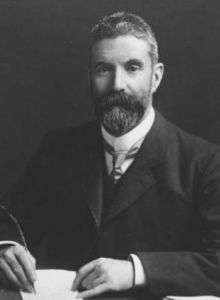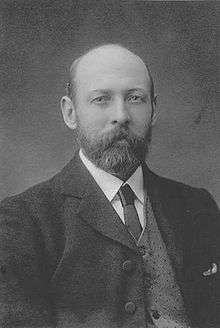Commonwealth Liberal Party
Commonwealth Liberal Party | |
|---|---|
| Historic leaders |
Alfred Deakin, Joseph Cook |
| Founded | 1909 |
| Dissolved | 1916 |
| Merger of |
Protectionist Party, Free Trade Party |
| Merged into | Nationalist Party of Australia |
| Headquarters | Canberra |
| Ideology | Liberalism (Australian) |
| Political position | Centre-right |
| International affiliation | None |
The Commonwealth Liberal Party (CLP, also known as the Deakin–Cook Party, The Fusion, or the Deakinite Liberal Party) was a political movement active in Australia from 1909 to 1917, shortly after Federation. The CLP came about as a result of a merger between the two non-Labor parties, the Protectionist Party and the Anti-Socialist Party (formerly Free Trade Party) which most of their MPs accepted. The CLP is the earliest direct ancestor of the current Liberal Party of Australia.
History


George Reid adopted a strategy of trying to reorient the party system along Labour vs non-Labour lines – prior to the 1906 election, he renamed his Free Trade Party to the Anti-Socialist Party. Reid envisaged a spectrum running from socialist to anti-socialist, with the Protectionist Party in the middle. This attempt struck a chord with politicians who were steeped in the Westminster tradition and regarded a two-party system as very much the norm.[1]
The Commonwealth Liberal Party was formed in response to Labor forming its second government under Andrew Fisher in 1908. Under considerable pressure from middle- and upper-class interests, Alfred Deakin, the leader of the Protectionists, and Joseph Cook, leader of the Anti-Socialists, joined forces in order to counter Labor's growing popularity. In 1909, the two parties at a meeting in Melbourne's Parliament House agreed to merge into the CLP, based on a shared anti-Labor platform. Deakin was the new party's first leader, with Cook as deputy leader. The merger didn't sit well with several of the more liberal Protectionists, who defected to Labor or sat as independents.
Between them, the Protectionists and Anti-Socialists held a majority of seats on the floor of the House of Representatives. As a result, the newly merged party used its numbers to force Fisher to hand power to Deakin. However, the CLP was defeated by Labor at the 1910 election, which saw Labor with an elected majority in both houses, the first federal occurrence for a party.
Cook took over the leadership from Deakin shortly before the 1913 election and won government by a single seat. However, only a year later, Cook deliberately introduced a bill abolishing preferential treatment for public-service union members. Cook knew the Labor-controlled Senate would vote the bill down, giving him an excuse to call a double dissolution election, the first time one would be called. When the Senate rejected the bill twice, Cook called the 1914 election. The CLP was again defeated with Labor again winning a majority in both houses.
The CLP remained in opposition until November 1916, when it reached a confidence and supply agreement with Prime Minister Billy Hughes, who had recently been expelled from Labor for supporting conscription in World War I and organised his followers as the National Labor Party. In February 1917, the CLP and National Labor formally merged to form the Nationalist Party of Australia. Although the merged party was dominated by former Liberals, Hughes became its leader with Cook as his deputy. Hughes would stay on as Prime Minister until the 1922 election where the new Country Party of Australia (later The Nationals) stripped the Nationalists of their majority, and demanded his resignation in exchange for confidence and supply. Stanley Bruce subsequently became Prime Minister.
The Commonwealth Liberal Party is often referred to by the retronym "Deakinite Liberal Party" in order to distinguish it from the later Liberal Party of Australia, which was officially founded in 1945.
Electoral results
Parliament of Australia
| House of Representatives | ||||||
| Election year | # of overall votes |
% of overall vote |
# of overall seats won |
+/– | Leader | |
|---|---|---|---|---|---|---|
| 1910 | 596,350 (#2) | 45.09 | 31 / 75 |
|
| |
| 1913 | 930,076 (#1) | 48.94 | 38 / 75 |
|
| |
| 1914 | 796,397 (#2) | 47.21 | 32 / 75 |
|
| |
| Senate | ||||||
| Election year | # of overall votes |
% of overall vote |
# of overall seats won |
+/– | Leader | |
|---|---|---|---|---|---|---|
| 1910 | 1,830,353 (#2) | 45.55 | 14 / 36 |
|
| |
| 1913 | 2,840,420 (#1) | 49.38 | 7 / 36 |
|
| |
| 1914 | 5,605,305 (#2) | 47.77 | 5 / 36 |
|
| |
Leaders
- Alfred Deakin 1909–13
- Joseph Cook 1913–16
See also
References
External links
 Media related to Commonwealth Liberal Party at Wikimedia Commons
Media related to Commonwealth Liberal Party at Wikimedia Commons